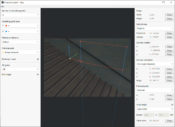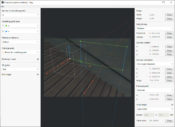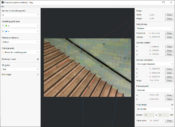- Review
fSpy is a free, open-source application designed for still image camera matching, enabling users to extract accurate camera parameters from photographs.
This functionality is particularly beneficial for 3D artists and architects who aim to integrate 3D models seamlessly into existing images.
Accurate Camera Parameter Extraction
By identifying vanishing points and defining perpendicular directions within an image, fSpy calculates precise camera parameters, including focal length, orientation, and position.
This process ensures that 3D models align accurately with the perspective of the background image, enhancing realism in composite scenes.
Seamless Integration with Blender
fSpy offers an official importer add-on for Blender, facilitating the direct transfer of camera parameters and background images into the 3D modeling environment.
This integration streamlines workflows for Blender users, allowing for efficient scene setup and model alignment.
User-Friendly Interface
The application features an intuitive interface where users can easily set control points and vanishing lines to define the perspective of the image.
Real-time feedback and adjustable settings make the calibration process straightforward, even for those new to camera matching techniques.
Pros and Cons
Pros:
- Precision: Delivers accurate camera parameter extraction for realistic 3D model integration.
- Blender Integration: Official add-on support enhances workflow efficiency for Blender users.
- User-Friendly: Intuitive interface simplifies the camera matching process.
- Cross-Platform: Available on multiple operating systems.
- Open Source: Free to use and open for community development.
Cons:
- Limited to Still Images: Designed specifically for still image camera matching; not suitable for video footage.
- Manual Input Required: Accuracy depends on the user’s ability to correctly identify vanishing points and set control lines.
FAQs
1. What is fSpy used for?
This tool is used to extract camera parameters from still images, facilitating accurate alignment of 3D models within photographs.
2. Is it compatible with Blender?
Yes, it offers an official importer add-on for seamless integration with Blender.
3. Can it be used with other 3D applications?
While it has official support for Blender, camera parameters can be manually transferred to other 3D applications that allow for such input.
4. Does it work with video files?
No, it is designed for still image camera matching and does not support video footage.
5. How accurate is it in extracting camera parameters?
The accuracy largely depends on the correct identification of vanishing points and precise placement of control lines by the user.
Conclusion
fSpy is a valuable tool for 3D artists and designers seeking to integrate 3D models into photographs with precision. Its accurate camera parameter extraction, seamless Blender integration, and user-friendly interface make it an essential application for achieving realistic composites.
As an open-source, cross-platform solution, fSpy continues to be a preferred choice for professionals and hobbyists alike in the realm of 3D modeling and visualization.







